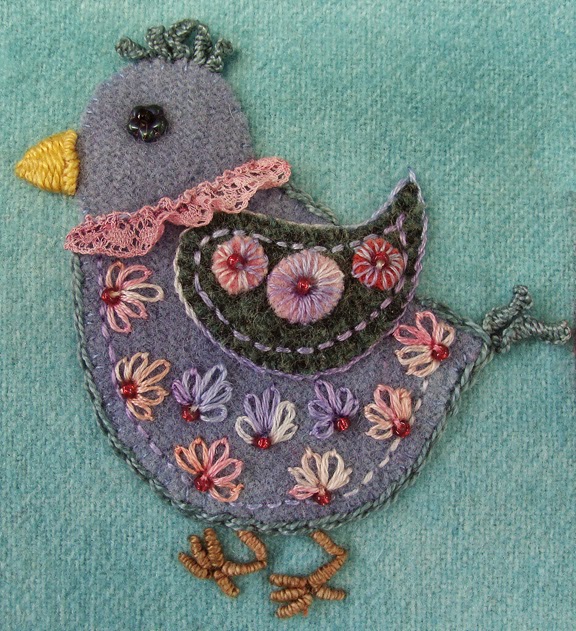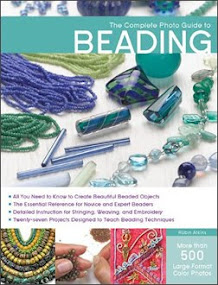I started this project in October, 2014, so I would have a nice handwork project while traveling for a month in Europe. I love it!!!
A bunch of pre-cut threads and trims, a small package of mixed seed beads/buttons/sequins, a folded piece of felt with various sizes of needles, embroidery scissors,
Sue Spargo's book, and 16 wool chicks already stitched to the background wool fit very nicely into a 12 x 9 inch zippered, mesh bag.... perfect to tuck into my backpack! I stitched on the airplanes, in people's homes, and with my beady/quilty friends! At the end of the month, 8 chicks were finished.
You can see them here.
Since then, I've been busy making a
Travel Diary quilt, and starting another very challenging "Shimmer" quilt, which will be the subject of the next post. However, once in a while, the Chicks are just the right break from machine sewing. Working on them makes me happy and peaceful.
The new ones are in this post... As you can see in the photo below, I still have 2 chicks to embellish, plus one that might need something more.
When all of them are finished, it will be time to decide what to do with them. My idea so far is to make them into a small wall quilt, hand quilting around the chicks, maybe adding a few flowers between some of the chicks. I'll wait to decide, keeping all options open until the chicks are finished.
Most of the chicks are girls, but so far 3 of them seem to have a bit of testosterone... can you tell which ones are the boys? You'll need to click on the above picture of all 16 to enlarge it enough to find the boys. If you feel like making a guess, let's give them numbers starting at the top left with 1 and going across row by row. As you can probably tell, the one below is definitely a girly girl!
By the way, the lace trim on the above chick is vintage lace from
LaDonne Weinland, an Etsy vendor. It was white, which was too "strong" a color for this piece. So I painted dye on it!!! These are the pieces I painted. To give you an idea of scale, the lace is just under 1/4" wide. The chick, from the bottoms of her feet to the top of her crown, is exactly 3 inches tall.
Threads!
People ask me where I got all the threads I use for these chicks. Here are some answers...
Variegated pearl cotton. I'd estimate that over half the stitches (all the beaks and feet, most of the edge stitches, tails, and top-knots) are pearl cotton, size 8 or 12. I like using threads that are subtly variegated. DMC and Valdani are two brands of pearl cotton that come in a ball for $5 to $7 per ball. I have purchased some Valdani balls from
Sue Spargo and
some from this site.
But most of my perle cotton comes from
African Folklore Embroidery ... Leora Raikin, the owner, packages hand-dyed, variegated, pearl cotton on cards of three colors, each color about 10 yards in length, for $5. She has a HUGE selection, from which you can have 24 colors for only $40!!! I love the colors, the subtle changes of colors in the variegation, and the quality of the thread. Here's
a page that shows her colors in size 8 pearl cotton... mind boggling!
 |
| My photo does not show the full amount you get... only how it is packaged, 3 colors to a card! |
|
Embroidery floss. For finer stitches and details, I often switch to regular embroidery floss. Again I gravitate toward the variegated colors. DMC has put out a lot of new variegated skeins in recent years. If you have an older supply of solid colors, you might want to check out DMC's 24 new colors.
Here's an Etsy seller that offers them. Or, if you are in the Seattle area, Nancy's Sewing Basket (on Queen Anne hill) stocks all of them. They are much more subtle than previous DMC variegated floss choices, more like hand-dyed. Anchor has also added nice options to their line.
I also buy hand-dyed embroidery floss when I see a skein that appeals to me. Again, I like the subtlety of it.
Other threads. Sue Spargo offers a line of variegated silk threads in beautiful colors, which she calls
Silken Pearl. I bought some of them from her during the class, and have enjoyed using them. The sheen of the silk is a lovely contrast to the more matte quality of the pearl cotton.
In her book, Sue recommends using a wool thread to applique the wool chicks to the background wool. Since it is quite expensive, I used 60 weight cotton applique/sewing thread by Metler, which I already had in a range of colors. It works fine. If I didn't already have the Metler thread, I probably would have bought a set of
Genziana wool threads on bobbins on Etsy,
here. This wool thread is a bit too fine for embellishment work, but it's great for wool applique.
Novelty yarns, metallic threads, chenille, dazzle threads, etc. all have their occasional use as well. As I tend to like more matte and less bling, I don't often use these threads. But it's fun to experiment with them. I did use chenille on one of the above chicks... can you find it?











































